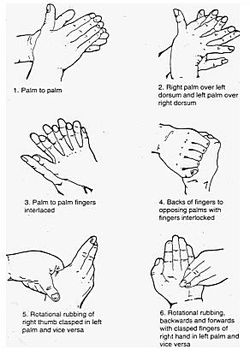- 23Nov2009
-
Hand Washing 101.
- By Ian Bradley
- 0 Comments
We all know that we should do it, our mothers told us to do it and now, our employers are telling us to:
Wash Our Hands
Thanks to a study by Grayson et al published in the Clinical Infectious Diseases 2009; 48:28-91, we have scientific proof that washing your hands with soap and water is a highly effective way of eliminating the H1N1 virus. In fact, in one measure of efficacy, soap and water actually bettered alcohol-based sanitizers.
That’s fine, but as a university professor and practicing clinical psychologist, I appeared not to know how to actually wash my hands. That’s before I read Dr. Carter’s definitive article in the Journal of National Medical Association that outlined the required steps:
Step 1 The Materials:
When using liquid soap, apply 3 to 5 milliliters to your hands and lather thoroughly.
If using bar soap, rinse the bar before and after using.
Use warm water, not hot, because hot water tends to open the pores and remove skin oils.
Step 2. The Action
Wash your hands, using vigorous friction, for at least 10
to 15 seconds, taking the time to wash between the fingers, on the palms and
backs of both hands, and under the fingernails.
If the hands are not visibly soiled, wash to about one inch
above the wrist. If the hands are contaminated, wash an
inch above that. After the wash is complete, rinse thoroughly
and blot with paper towels.
Step 3 The Finale
Touch nothing after the hands have been
cleaned. Use a paper towel to turn off the faucets and
open the door.

However, the question remains: now that we know how to do it, will we do it?
First of all, and long before H1N1 became an international preoccupation; hospitals were concerned about health care workers not washing their hands. Numerous reports were published about the surprisingly high percentage of medical folks who move from completing a medical procedure on one patient to the next patient without washing their hands. In one 2004 study by Girou et al, health care workers either failed to wash their hands &/or remove their gloves in 64% of caseswhere such action was required. Although some of the workers honestly believed that such hygiene was not required, most said that they were simply too busy or lacked access to a sink with soap and water.
In community studies, the data is equally grim. From observational research in public washrooms (Wirthlin Worldwide Research, 1996) – research that must have a disproportionate share of untoward events – international compliance for hand washing was approximately 50%. Numerous studies have shown that male were less compliant than females, that people often wash without using soap and that the time of washing is less than 5 seconds.
All these rather shocking revelations present a challenge to workplace campaigns to get employees to adopt proper hand hygiene.
In my next post, I’ll describe several helpful psychological tips that might improve the situation.

COMMENTS